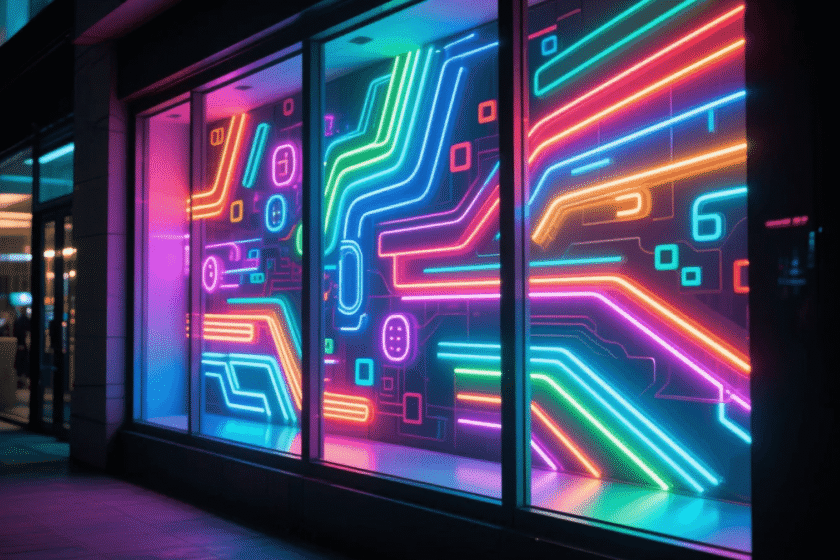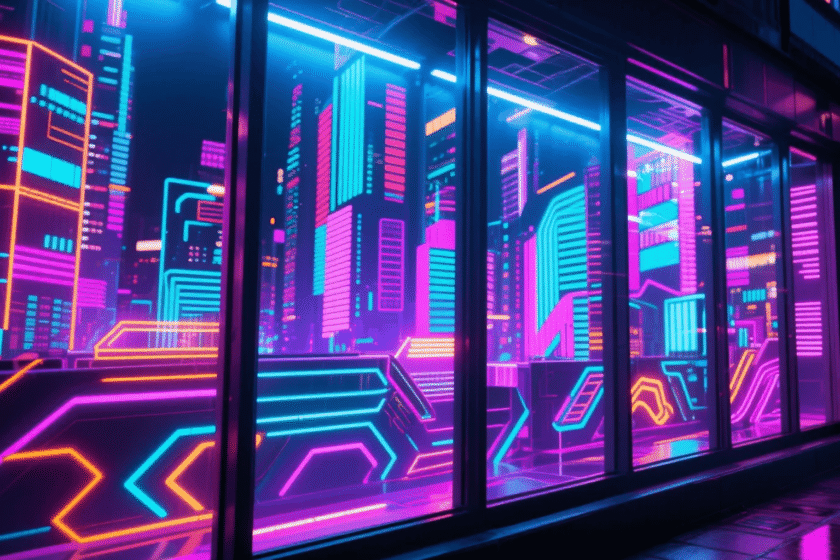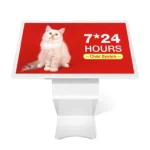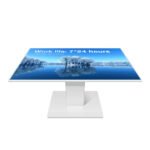Is a High Brightness LED Window Display Worth the Investment for Your Digital Signage Strategy?
The landscape of retail and real estate advertising has been irrevocably altered by the shift to digital signage. Within this evolution, one technology stands out for its unique ability to capture attention in the most challenging environments: the LED window display. This technology is not merely an upgrade from static posters or conventional LCD screens; it represents a fundamental rethinking of the storefront as a dynamic communication channel. For businesses focused on maximizing foot traffic conversion and brand visibility, understanding the profound impact and operational nuances of these high-brightness solutions is paramount.
Understanding the Power of the LED Window Display

The core value proposition of an LED window display lies in its capacity to deliver vivid, high-impact content visible even under direct sunlight. Traditional displays often struggle with “washout”—a significant loss of color and contrast when exposed to bright ambient light. In contrast, LED window displays are engineered with exceptional brightness levels, frequently exceeding 4,000 to 7,000 nits, ensuring that promotional videos, striking graphics, and real-time information remain brilliantly clear. This high luminosity is crucial, as the primary purpose of a street-facing screen is to engage passersby—individuals who are moving, distracted, and often battling visual noise from the surrounding environment.
Furthermore, these specialized displays are designed to operate reliably in a demanding semi-outdoor setting. They often feature robust construction, sophisticated thermal management systems, and specialized components that resist UV degradation. Consequently, they maintain their performance and lifespan, representing a durable investment rather than a temporary fix. They bridge the gap between the interior sales floor and the exterior world, creating a seamless visual path that draws potential customers inside. Consequently, for any high-street retail location or visible commercial property, this type of digital signage is fast becoming a standard expectation rather than a premium feature.
Key Characteristics Driving Digital Signage Adoption

The specific features of the LED window display make it uniquely suited for advanced digital signage applications, particularly those requiring dynamic updates and real-time interaction.
The Critical Role of High Brightness and Clarity
As previously emphasized, brightness is the undeniable headline feature. However, clarity and resolution are equally important. Modern LED technology allows for increasingly fine pixel pitches, meaning the physical distance between the LED clusters is shrinking. This evolution allows for high-definition (HD) or even ultra-high-definition (UHD) content delivery, even at relatively close viewing distances. When combined with a high refresh rate, the resultant video playback is smooth, compelling, and free of visual artifacts, which is essential for presenting sophisticated brand messaging. This high fidelity ensures that the brand image projected is one of quality and professionalism.
Flexibility in Size and Configuration
Unlike standard commercial-off-the-shelf (COTS) displays, LED modules offer unparalleled flexibility in size and shape. Businesses are not confined to standard rectangular aspect ratios. Custom solutions can be designed to wrap around architectural elements, occupy irregular window spaces, or form massive, attention-commanding video walls. This modularity allows the display to become a fully integrated part of the building’s facade or interior design, maximizing the available real estate and offering unique aesthetic possibilities that static or fixed-format signage cannot match. The adaptability of the LED window display is a significant driver of creative digital strategy.
Advanced Content Management and Operational Efficiency
A truly valuable digital signage solution is defined by its ease of content management. Modern LED window displays are integrated into powerful content management systems (CMS). These platforms allow users—often marketing teams or property managers—to schedule, update, and manage campaigns across single or multiple locations remotely. This level of control drastically cuts down on the operational expenses associated with printing, distributing, and installing physical signage. Furthermore, it enables agile marketing: prices, promotions, and time-sensitive announcements can be updated instantly in response to weather, inventory, or competitor actions, providing a tangible competitive edge. The capacity for real-time responsiveness is what truly differentiates this medium.
The Strategic Application in Digital Signage Sectors

The adoption of LED window displays is most pronounced in sectors where the immediate capture of public attention translates directly into revenue or tenancy interest.
Retail and Consumer Engagement
For retailers, the window is the primary sales tool. A static mannequin display may change weekly, but a dynamic LED window display can change every hour. It can showcase a range of products, promote flash sales, display live social media feeds, or even offer interactive QR codes for immediate mobile engagement. This dynamic capability transforms a passive viewing experience into an active interaction point. For example, a fashion retailer can instantly switch the display from showcasing winter coats to spring dresses based on a sudden change in temperature, creating a direct and timely connection with potential buyers. This immediate relevance significantly boosts the likelihood of conversion.
Real Estate and Property Marketing
In the competitive real estate market, visibility and perceived value are crucial. Real estate agencies are increasingly leveraging these displays to showcase high-resolution imagery and virtual tours of properties for sale or lease. By displaying captivating visuals and essential property details at high brightness, they create a 24/7 “open house” effect. Prospective tenants or buyers are provided with substantial information after hours, keeping the agency engaged with the market around the clock. The sophistication of the display itself often reflects the high value and modernity of the properties being advertised, enhancing the overall brand perception.
Corporate and Public Service Communication
Beyond traditional retail, corporate headquarters and public service institutions utilize these displays for high-visibility internal and external communications. Banks might use them to display fluctuating interest rates or new product launches, while public transport hubs deploy them for critical real-time schedule updates and safety announcements. The sheer visibility of the LED window display makes it an indispensable tool for delivering information that must be seen by a wide and diverse audience instantly. Its reliability in various operational conditions ensures that critical messages are always available.
Analyzing the Return on Investment (ROI)
While the initial capital expenditure for a high-brightness LED window display is higher than that of standard screens, the long-term ROI is compelling, particularly when the complete lifecycle costs are considered. The return is generated through several key areas.
Firstly, the most direct benefit is the documented increase in foot traffic and sales conversion. A display that is two or three times brighter than its competition is simply noticed more often, translating directly into a larger audience pool. Secondly, the savings realized from eliminating recurring print and installation costs for traditional advertisements accumulate rapidly. A single large-format print advertisement can be expensive, and if it changes monthly, the cumulative cost quickly justifies the digital investment. Finally, the strategic value of brand enhancement cannot be overstated. A modern, vibrant, and constantly updated window display projects an image of innovation and success, which contributes to long-term brand loyalty and competitive positioning. This technology is viewed as a long-term asset that drives continuous engagement.
Conclusion: A Future Defined by Dynamic Engagement
In summary, the integration of a high-brightness LED window display is a decisive step for any business committed to excelling in the digital signage arena. It offers a crucial trifecta of benefits: unmatched visual performance under challenging lighting conditions, flexibility in creative design and integration, and powerful operational efficiency through advanced content management. For digital signage product users in retail, property, and beyond, the display is not a simple advertising screen—it is a sophisticated, high-performance communication platform. Investing in this technology is essentially investing in guaranteed visibility, immediate responsiveness, and a demonstrably stronger connection with the consumer at the most critical juncture: the point of entry. The evidence strongly suggests that, for businesses serious about capturing the attention of a fast-moving, digitally-savvy public, the investment is not just worthwhile, but increasingly essential.
Frequently Asked Questions (FAQ)
Q1: How does a standard commercial LCD screen compare to a high-brightness LED window display in terms of visibility?
A standard commercial LCD often maxes out around 700 to 1,000 nits of brightness. Under direct sunlight or strong ambient daylight, its content will appear washed out and unreadable. A high-brightness LED window display operates in the range of 4,000 to 7,000+ nits, making its content vividly clear and high-impact even in the brightest conditions, ensuring message clarity 24/7.
Q2: What is “pixel pitch” and why is it important for a window display?
Pixel pitch refers to the distance in millimeters between the centers of adjacent LED clusters (pixels). A smaller pixel pitch means more pixels in a given area, resulting in higher resolution and sharper images. For a window display where viewers may be standing relatively close, a fine (small) pixel pitch is necessary to ensure smooth, high-definition content without visible pixelation.
Q3: Are LED window displays expensive to run continuously?
While modern LED technology is significantly more energy-efficient than older display types, a high-brightness LED window display consumes more power than a standard indoor screen due to the sheer intensity of its light output. However, this cost is typically offset by the elimination of recurring print advertising expenses and the substantial increase in potential sales conversion driven by the display’s effectiveness.
Q4: Can these displays be used in very hot or cold climates?
Yes, reputable commercial-grade LED window displays are engineered with advanced cooling systems and durable components designed to withstand a wide range of operating temperatures. Specialized thermal management ensures the display maintains optimal performance and longevity, regardless of external weather conditions.



